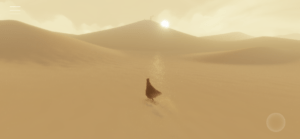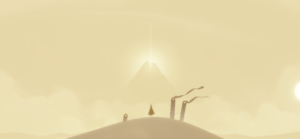The game I chose was Journey. Journey was directed by Jenova Chen, co-developed by Thatgamecompany and Santa Monica Studio, and published by Sony Computer Entertainment. The target audience of the game seems like people with patience and who enjoy exploration and wandering without prioritizing thrills or challenges.
The player dynamic of the game is player vs the game, although I am not certain if it’s possible to “win” the game at the end. During the playtest, it seemed like I could get to various objects that extended the desert and built on drawings that appeared throughout the game, but I wasn’t certain what this all meant. The objective of the game is exploration as you manipulate the character to walk around the desert and find different structures. The game has fairly simple procedures and rules. You walk. But you can’t walk through obstacles and you can jump a certain height. You can also find flying brown objects to gain the ability to jump higher. You walk through the desert until you, the player, are tired (in real life) and want to stop playing. I couldn’t really spot the resources of the game as the character doesn’t seem to die or get hurt nor gain or lost anything. One notable thing at the beginning of the game is the white shiny flying paper pieces that land on you when you get close. Once you are “charged” with those, you can jump higher and if you use them up, you can’t. I think the most noticeable formal element of the game is its boundary. The graphics of the game attracts attention and makes you feel like you are walking through the desert while the sun is setting. Moreover, because the character you control doesn’t look like a human, the game is able to draw an even stronger boundary between the real-life and the game itself. My first success was when I unlocked the first castle.
I believe the type of fun that the game intended was tranquility and personal satisfaction. From the one hour I spent on the game, it seemed like there wasn’t a way to compare your achievements or progress in the game with others. The game seemed like it gives more personal satisfaction. Additionally, its design and dynamic created tranquil feelings, allowing players to play the game without being nervous or strategic. Therefore, I think the game intends to bring fun through tranquility and personal achievements. The game also brings fun through its beautiful visual design. The design strongly reminds me of monument valley.
I think the biggest thing I would change about the game is giving clearer instructions in the beginning or depicting the background story or the narrative a little bit. This game taught me that walking simulators aren’t really my favorite type of game. As a person who likes to achieve things, I felt like I was wasting time because I wasn’t “doing” anything in the game. However, I think the biggest reason why I had a hard time getting into the game was its lack of description. There was no writing or any other instructions on what the game is about, what we are trying/supposed to do, and how to play it. Therefore, I was very confused about how to get the game started and what I should begin. It also took me a while to figure out how to control the character or what each motion meant in the game. My boyfriend had to help me figure this out before I was able to start playing the game. It was interesting to explore and put the bits and pieces together to guess what we were trying to achieve and what this story was about, but it felt really burdensome especially after spending lots of time figuring out how the game works. Another thing that I might fix is increasing the contrast between the background and the button that appear, especially at the beginning of the game. I understand that low contrast between the buttons and the background interferes with the design minimally and makes the game look pristine. However, it was often difficult to see the buttons or notice new buttons. Therefore, I think more noticeable buttons at the beginning of the game would help unfamiliar players learn the game more quickly. Playtesting Journey made me agree very much with Clark’s article.
Despite my inability to actually be absorbed into the game, I think it is a really beautiful game. The motions are very swift and real and the graphics of the character are very realistic. I also loved that the game marks important pieces by making them glow. This aspect added to the pristine and grandiose aesthetic of the game.





